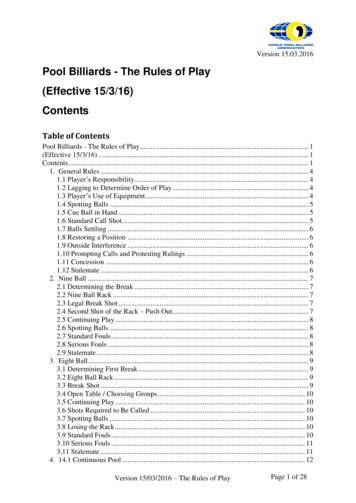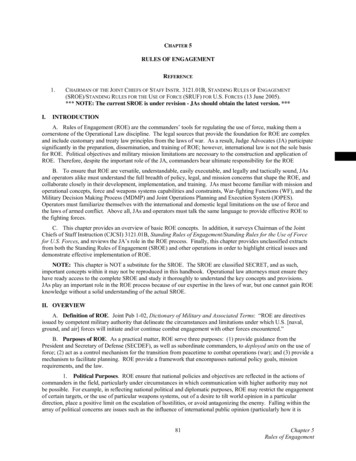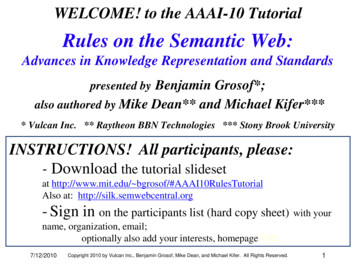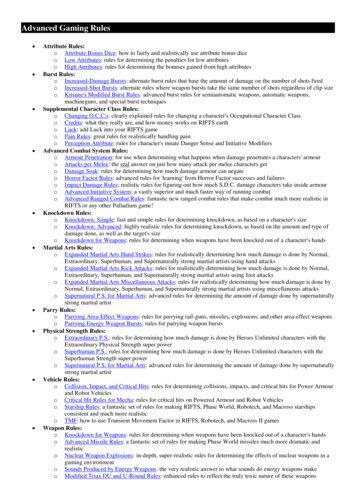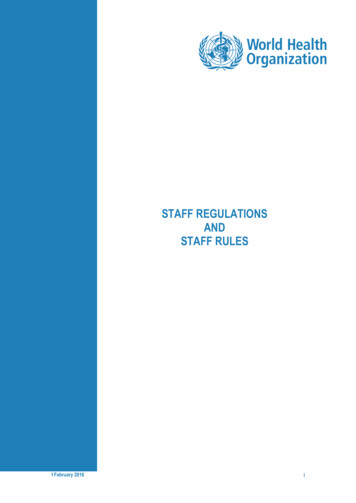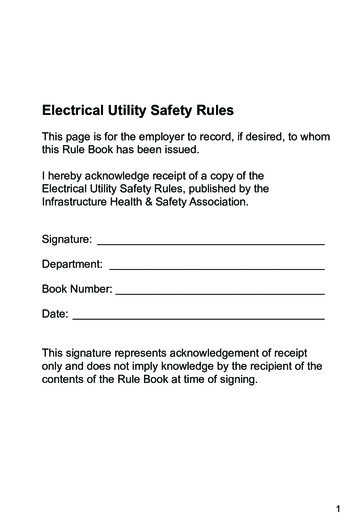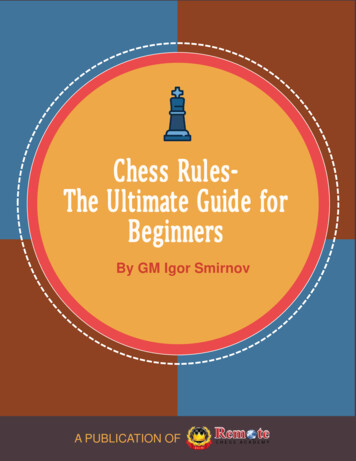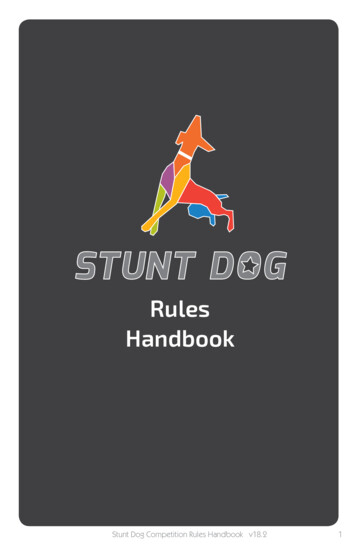
Transcription
RulesHandbookStunt Dog Competition Rules Handbook v18.21
Do More With Your Dog! 44404 16th St. West, Suite 204Lancaster, CA 93534, USAinfo@domorewithyourdog.com(661) 942-2429 domorewithyourdog.com 2018 Do More With Your Dog! All rights reserved. No part of this publication may be reproduced, stored in a retrieval system, ortransmitted, in any form or by any means, electronic, mechanical, photocopying, recording, or otherwise,without prior written permission from the publisher.Stunt Dog Rules HandbookRulesHandbook“Do More With Your Dog!” is a registered trademark of Kyra Sundance (domorewithyourdog.com)Due to differing conditions, materials, and skill levels, the publisher and various manufacturers disclaimany liability for unsatisfactory results or injury due to improper use of tools, materials, or information.Printed in the USA2Stunt Dog Competition Rules Handbook v18.2Stunt Dog Competition Rules Handbook v18.23
Dear Trick Doggers,“Stunt Dog” is a term applied to any kind of live trick dog showperformance; whether it be athletic, a comedy skit, a dance routine,obedience demo, or demo of a dog’s intelligence. Dog tricks inspire andentertain audiences, and we want to give you the skills and the forum to doso successfully.I’ve spent my career as a professional Stunt Dog performer, performing atcircuses, theaters, and sporting event halftime shows. I’ve performed atfairs with dogs in the audience, and popcorn, and fireworks, and livestockand kids, and practically every distraction you can name! Through thisexperience I’ve developed strategies for keeping control of my dogs; thingslike pedestal training and environment manipulation.I want you to have the same positive experience performing your tricks inthe ring as I have had. It is with this goal that I structured the Stunt Dogring sport.circle with your dog on your left places your body between the ring fenceand your dog, shielding him from audience distractions. These details willhelp you and your dog be successful.Between every exercise your dog returns to the pedestal; to keep himcontained and focused. This helpful technique is one that I rely upon in mylive shows, and one that will work for you as well.PATTERN TRAINING:The first four levels of the Stunt Dog title are called the Foundation levels.The structure stays the same throughout the Foundation levels; only addingor removing a few elements, or changing their difficulty. By the time you getto the Champion level, you will feel comfortable and confident in the ring,and have a successful structure to build upon.STRUCTURED TO MAKE YOU SUCCESSFUL:Costumes and skits are not allowed in the Foundation levels. Before youadd these creative elements, we want you to prove you can handle yourdog in the ring and execute off-leash control in a variety of tests. We alsowant to keep you focused on your performance.Every level of Stunt Dog trial begins with your dog on the pedestal. The firstscored exercise is a counter-clockwise circle around the ring perimeter. This,like every element of the Stunt Dog competition, was specifically designedto give you the highest chance of success. The pedestal is in the center ofthe ring; the farthest spot from audience distractions. The counter-clockwiseStunt Dog judges are explicitly directed to give only positive verbal feedbackto the performer, regardless of score— we want you to feel good leavingthe ring. Judges are not stoic onlookers merely grading you; they are “thecompetitor’s friend.” The judge will, by using verbal advice, try as much aspossible to help you succeed.I’m so excited for you and your dog to begin this exciting new adventure!Kyra Sundance, CEODo More With Your Dog!4Stunt Dog Competition Rules Handbook v18.2Stunt Dog Competition Rules Handbook v18.25
PROTOCOLPOSITIONSFollowing is a list of general rules and definitions.READY POSITION:RING AND REGULATION PROPS:A pedestal is universally employed in live animal performances. It serves asa home-base for the dog, and is trained as a rewarding place. It keeps theperformance controlled, as it prevents the dog from wandering.RING FENCE:Competition ring is 30ft x 30ft with a front entrance and rear exit. Duringcompetition, entrance/exit gates will be closed to prevent the dog fromrunning out. Audience must stay 6 feet away from ring fence.PROPS:The 3 required props will be provided for you in the ring. The Klimb-brandpedestal may not be substituted with another pedestal, however you maybring and use your own target mark and hoop. These three props areavailable for purchase as part of the “Stunt Dog Competition Pack.”Prop #1: Pedestal:The pedestal shall be a Blue-9 Klimb (24"x24"x12"). Handler maybring a step for their small or limited-mobility dog. Only one pedestal isallowed, even for giant breeds. There will be no carpet or other surfaceon top of the pedestal (as they retain dog smells). The judge will wipedown the pedestal between competitors.Prop #2: Target Mark:Shall be no larger than 12" diameter and 1.25" height. May be anycolor, texture, shape, substance. The regulation wooden disc includedin the official Stunt Dog Competition Pack is heavy wood and a goodchoice. You may wish to decorate it. It is smart to each side differently,so it can stand out on any floor color.Prop #3: Hoop:A rigid, circle hoop of any size.TIME LIMITSA time limit exists of 6 minutes for Novice, Open, and Proven, and 10minutes for Professional and Champion levels. Time starts at the specifiedstart time when the competitor may enter the ring. If the dog does not passan exercise, the team may still continue to finish their trial.6Stunt Dog Competition Rules Handbook v18.2The Ready Position is assumed at the start and finish of most exercises.The dog is on the pedi, in any position (sit, stand, down) with the handlerfacing stage-front, to the right of the pedi. The handler stands in any formalstance, such as with feet heel-to-toe and hands behind back, or otherposition that appears deliberate and not slouchy.STAGE FRONT:The ring has a defined Stage Front where the audience typically sits. StageLeft and Right are defined from the perspective of the audience.STAGE LEFT AND COUNTER-CLOCKWISE:In several exercises the handler shall go to stage left. The handler shallnever go to stage right.In several exercises the handler shall circle the ring or the pedestal counterclockwise. In no instance will the handler circle clockwise.JUDGE’S DIRECTION TO COMPETITOREXERCISES:The judge’s direction to the competitor is not formal, but rather phrased asa helpful friend. The judge shall help the competitor with words, rather thanstanding silently and watching the competitor do the wrong thing.Competitors are scored only during the active periods of the exercise, andnot in between exercises. Penalties, however, can be incurred during thenon-active periods, at the judges discretion.AUDIENCE APPLAUSE:Applause is encourage during the entrance and exit perimeter ring circles.Stunt Dog Competition Rules Handbook v18.27
INTERACTION WITH YOUR DOG IN THE RINGTALKING:Handler may quietly direct and encourage his/her dog, except duringspecific “silent-cue” exercises. Points are deducted for harsh tones.TOUCHING DOG:During an exercise, handler should not guide or prod the dog through touch.LEASHES & COLLARS:Acceptable:Flat collarLimited slip collar (Martingale)HarnessBandana / Neck scarfSimple decorative collarNot Allowed:Remote collar (e-collar)Prong collar / Pinch collarFull-slip collar (choke-chain)Distracting, hanging tags/charmsBad treats (CRUMBLY):Rollover / dog food rollsChickenBread, crackers, popcornFish, sardinesHard, dry dog biscuitsSCORING AND PENALTIES:SCORING:To pass, competitor must receive a passing score in every exercise andmust achieve the minimum total point value.PENALTIES WHICH ARE AUTOMATIC NQS:TOYS:Small, subtle toys may be used in the ring in a subtle, quick manner as areward between exercises.COSTUMES:No dog coats, vests, capes, boots, anklets allowed in the Foundation levels.At the Champion level, dog and human costumes and props may be used.If a costume is used for the dog, we recommend merely a color-coordinatedcape, as some audiences are turned off by overly elaborate costumes. It isrecommended that the handler wear appropriate footwear.TV RESTRICTIONS:When televised (as at the Championship levels at TriDEx) there may berestrictions on copyrighted music and brand names. Restrictions mayinclude clothes/props with logos, website URLs, or other advertisements ormessages larger than 3 inches.TREATS:Handler may give treats (or touch or open his treat bag) only in-betweenexercises and only while on the pedestal. Treats must be contained in onesmall, waist treat bag or pocket. We don’t want treat crumbs to fall in thering, so treats must be large and not shred or crumble.8Good treats:Cheese cubesHot dog slicesHam or steak cubesNoodles or ravioliCheese puff ballsGreen BeansKibbleNon-crumbling packaged dog treatsStunt Dog Competition Rules Handbook v18.2 Dog relieving in the ringTreat dropping in ring or not contained in treat bag as specifiedAggressionA dog who is hurt, unhealthy, or unfit to performOther actions as determined by the judgePOINTS AT JUDGES DISCRETION:At the bottom of the scoresheet is a section where the judge may add orsubtract points at their discretion.Some reasons points may be subtracted:Unpleasant treatment of dog, poor grooming, unpleasant facial expression.Some reasons points may be added:Exceptional showmanship, exceptional “heart”, recognition of a team whoperformed at a high level in spite of limitations (very old age or physicalhandicap).SCORING PLACEMENTS:Placement for 1st, 2nd, 3rd will not be recognized as we do not wishto encourage a competitive culture amongst participants. An “Honor”recognition will be awarded to all competitors who achieve a 185 score.Stunt Dog Competition Rules Handbook v18.29
BITCHES IN SEASONBitches in season may compete, but must wear pants. They will be run lastin the day.BECOMING A JUDGE, HOLDING A TRIALTo become a judge, you must be a CTDI in good standing and must haveattended an “Intro to Stunt Dog Competition” workshop.TITLES, PREREQUISITES, AND LEGSTo enter the ring, the dog must have his Stunt Dog title in the previous leveland must also have his corresponding Trick Dog title. Only one passing legis required to earn a Stunt Dog title.Novice Stunt Dog (NSD)Prerequisite: Shall have earned their Novice Trick Dog titleOpen Stunt Dog (OSD)Prerequisite: Shall have earned their Novice Stunt Dog and theirIntermediate Trick Dog titlesProven Stunt Dog (PSD)Prerequisite: Shall have earned their Open Stunt Dog and their AdvancedTrick Dog titlesStunt Dog Professional (SDPro)Prerequisite: Shall have earned their Proven Stunt Dog and their ExpertTrick Dog titlesStunt Dog Champion (SDCH)Prerequisite: Shall have earned their Stunt Dog Professional and theirTrick Dog Champion titlesAKC TITLESStunt Dog titles may be sent to AKC to have them officially recognized onyour AKC registration, if you so choose.IN ORDER TO MAINTAIN YOUR JUDGES CREDENTIALS, YOU MUST EITHER: Attend TriDEx at least once every two years Preside as judge in a trial once per year Satisfactorily complete an online judge’s course once per yearHOLD A STUNT DOG TRIAL, AND JUDGE THE TRIALThe debut of Stunt Dog trials will be a TriDEx in March 2018. After that,judges may schedule and preside over local and regional Stunt Dog ringtrials in their area.To hold a trial, visit DoMoreWithYourDog.com to submit your requestand coordinate a location and date. Judges will be compensated with apercentage (33%) of entrance fees. Trials may be held anywhere in theworld.DMWYD will collect the entrance fees and provide the judge with the officiallist of competitors. After the trial, the judge shall communicate the trialresults to DMWYD.Your trial will be listed on the DoMoreWithYourDog.com website. Thewebsite will list the facility setup of each trial (ie: indoor/outdoor, grass,dirt, rubber matting, accordion fencing, boom box provided, etc) so thatpotential competitors can choose venues accordingly.A judge may judge their own student in the ring; we are confident in ourjudges’ ability to be impartial.10Stunt Dog Competition Rules Handbook v18.2Stunt Dog Competition Rules Handbook v18.211
OVERVIEW OF THE FOUNDATIONLEVELSThis grid illustrates, at a glance, the order and difficulty of the 9 to 10exercises required in each level.Notice that the structure stays the same throughout the levels; only addingor removing a few elements, or changing their difficulty.By the time you get to the Champion level, you will feel comfortable andconfident in the ring, and have a successful structure which you may wishto use as a basis for your Champion routine.ExerciseNoviceOpenProvenProff’lPerimeter Circle EntranceOn leashsameOff-leashOff-leashw/2 tricksMount Pedestal, ReadyPositionOn leashsameOff-leashAt fence6 ft, 5secs6 ft, 15secs2 ft6 ft10 ftAt fence1 trick2 tricksincl 1 Int.difficulty3 tricksincl 1 Int.difficulty4 tricks,incl 1 Int.difficulty1 trick,6 ft4 tricks,12 ftBegin on Pedestal in Ready PositionRemove leash“Stay” on Pedi, HandlerBacks Up“Stay” on Pedi, HandlerCircles itTricks on PedestalDistance Trick on PedestallRelocate to Stage FrontSend to PedestalFrom10 ftdistanceFromdistance offence6 ft, 5secs10 ft, 10secsRelocate to Stage BackSend to Target MarkDistance Trick on TargetMark1 trick, 63 tricks inft distance a row, 6 ftRelocate to Pedi, and then to Stage Front for hoopsHoop Jump4 jumps4 jumps4 jumps4 jumpsRelocate to Pedi, then Stage FrontTricks on the Floor2 tricks incl 3 tricks3 tricks1 at Int.incl 1 Adv, incl 1 Exp,difficulty1 prop1 propRelocate to PediSilent Cues3 tricks,on pedi orfloorPerimeter Circle Exit12Stunt Dog Competition Rules Handbook v18.2On leashOn leashOff-leashStunt Dog Competition Rules Handbook v18.2Off-leashw/2 tricks13
NOVICEDog:NOVICE STUNT DOGHandler:We understand that entering the ring can be a stressful endeavor, and theNovice test has been constructed in such a way as to make competitors assuccessful as possible.At the Novice level we do not expect a lot of showmanship. The goal is toget ring experience on the dog and the handler and get them comfortablewith the sequence of exercises, as this same sequence is required, inincreasing difficulty, at each level of Stunt Dog competition.Date:ExerciseNQPass1. Perimeter Circle Entrance05 10 152. Mount Pedestal, assume Ready Position05 10 153. “Stay” on Pedi010 15 204. Handler Circles Pedi010 20 255. Trick on Pedestal010 15 25010 15 2005 20 30On leash, counter-clockwiseOn leashRemove leashHandler backs up 6 feet, 5 secondsNOTES SPECIFIC TO NOVICE: The judge may wish to draw helpful chalk lines similar to the yellow linesin the diagram.TotalBegin on Pedestal in Ready Position2 feet distance1 trickRelocate to Stage Front6. Send to PedestalFrom 10 feet distanceSteward places Target Mark. Dog and Handler go to Stage Back7. Send to Target MarkEXITFrom 6 feet distance, stay on mark 5 secondsSTAGE BACKSTEWARDRelocate to Pedi. Steward removes Target. Steward hands hoops to Handler.8. Hoop JumpTARGET4 jumps/interactions05 15 3505 10 15Relocate to Pedi9. Perimeter Circle ExitOn leashScoring Adjustment (at judge’s discretion)Comments:Certified Judge:Judge: Return lower portion of scorecardto Do More With Your Dog! trial chair.DoMoreWithYourDog.comSTAGE FRONT14version 2017-12JUDGESTAGE LEFTSTAGE RIGHTTotal ScorePassing: 140 and must pass every exercise. Honors: 185 to 200.ENTRANCEStunt Dog Competition Rules Handbook v18.2Dog Name:Ticket:NOVICEPassNot Quite
NOVICEScoring:BEGIN ON PEDESTAL IN READY POSITIONThe steward wipes the pedestal with a rag. Steward opens the entrancegate and the judge invites the team into the ring, leashed. Theteam walks to the pedestal and assumes the Ready Position. Oncesettled,the judge instructs the handler to do their Perimeter CircleEntrance.05DID NOT COMPLETE THE CIRCLECOMPLETED THE CIRCLE WITH SIGNIFICANT PROBLEM10 SATISFACTORILY COMPLETED A CIRCLE, PERHAPS WITH A STALL15 VERY WELL, SMOOTH, CONSISTENT SPEEDAn Excellent Performance Looks Like:1. Perimeter Circle Entrance Handler makes eye contact and waves high to audience, presents him/herself well; confident stride. The dog is happy, moving at a comfortable pace, not tripping up thehandler. The dog need not be in heel position, but should not bestraining at the leash. Competitors look like a team.ON LEASH, COUNTER-CLOCKWISEIn a circus opening “spec” (spectacle), all of the performers and animalswalk the perimeter of the ring and wave to the audience.The team begins in the Ready Position, leashed. The team dismounts thepedestal, and walks or jogs first to Stage Right, continuing in a counterclockwise perimeter circle. The dog is on the handler’s left so the dog is onthe inside of the circle (where there are less distractions). The handler holdsthe leash in his/her left hand and waves to the audience with his/her righthand. There are to be no extra maneuvers such as leg weaves, spins, barks,or paw waves. Handler may quietly encourage and direct his/her dog.When the circle is finished, the team returns to the Ready Position (which isexercise #2) without waiting for judge’s direction. Exercises #1 and #2 areperformed together, but scored separately.Common Scoring Situations:LUNGING, LAGGINGPASS if dog is bouncing around a lot.NQ if handler has a significant difficulty controlling the dog.CHEATING THE CIRCLEPASS if the person cuts some corners.NQ if they cut a lot of corners.NOT FOLLOWING DIRECTIONSNQ if they do the circle clockwise, have the dog in their right hand, donot begin and end in Ready Position.STAGE BACKTips:STAGE LEFTSTAGE RIGHT You have 6 minutes in the ring. You may wish to take a minute or two ofyour 6 at the very beginning, to settle your dog on the pedestal beforeyou start your first exercise. When dismounting the pedi, start with your right foot and body block thedog on the pedi for a step or two, until you are facing stage right.STAGE FRONT16Stunt Dog Competition Rules Handbook v18.2Stunt Dog Competition Rules Handbook v18.217
NOVICE2. Mount Pedestal, assume Ready PositionScoring:ON LEASH05After completing the circle in exercise #1, team does not wait for judge’sdirection, but goes directly to the pedestal and into Ready Position. Theloose leash is held in the left hand.Handler may place a step next to the pedi to help small or limited-mobilitydogs mount.DID NOT MOUNT THE PEDESTAL IN A TIMELY MANNERJUMPED OFF THE PEDI MORE THAN ONCE10 MOUNTED, JUMPED OFF ONCE, WIGGLED AROUND15 MOUNTED EASILY AND STAYED THEREAn Excellent Performance Looks Like: Dog mounts easily, handler gracefully assumes Ready Position withconfident body posture and smile. Loose leash in left hand.Tips: In the Ready Position, it is better to do heelto-toe with your RIGHT foot in front, as thisangles your chest TOWARD your dog, andnot away.Common Scoring Situations:JUMPING OFF THE PEDIPASS if dog jumps off onceNQ if dog jumps off repeatedlySTAGE BACKSTAGE LEFTSTAGE RIGHTSTAGE FRONT18Stunt Dog Competition Rules Handbook v18.2Stunt Dog Competition Rules Handbook v18.219
NOVICEREMOVE LEASHJudge asks the handler to remove the leash and hand to the judge. Thedog should remain on the pedestal.Scoring:0 DOG JUMPED OFF PEDI DURING THE STAY10 HANDLER WENT FORWARD BEFORE 5 SECONDS15 HANDLER GAVE REPEATED COMMANDS20 SMILING, CALM, SMOOTH3. “Stay” on PediHANDLER BACKS UP 6 FEET, 5 SECONDSAn Excellent Performance Looks Like:Handler pivots in place to face their dog, give a verbal cue and/or handsignal, and backs up toward stage-left (approximately 6 feet). The judgecounts aloud “5-4-3-2-1, return to your dog” at which time the handlerreturns to Ready Position.Tips: The easiest way to set your dog up for success is to pivot, say “stay”and hold up your palm in a traffic-cop signal, wait a second to makesure your dog is going to stay, and then walk backward 6 feet with yourpalm raised the entire time. When you return, keep your palm up untilyou have completely returned to your dog. Be aware that lowering yourhand may make your dog think there is a treat in your hand and he mayjump off the pedi trying to follow that hand. The team is confident and smooth. A spectator does not have anxietythinking the dog is about to break. Both dog and handler look pleasantand calm.Common Scoring Situations:REPEATED CUESPASS if handler gives a few additional, calm cues to “stay”NQ if commands are loud or harshCUTTING THE 5 SECONDS SHORTPASS if handler stops in the middle of walking backwardsNQ if the handler walks forward before being told to do soSTAGE BACKSTAGE LEFTSTAGE RIGHTSTARTFINISHSTAGE FRONT20Stunt Dog Competition Rules Handbook v18.2Stunt Dog Competition Rules Handbook v18.221
NOVICE4. Handler Circles PediScoring:2 FEET DISTANCE0 DOG JUMPED OFF THE PEDI10 THE CIRCLE WAS OVERLY SLOW OR WITH REPEATED INTERRUPTIONSFrom Ready Position, handler tells dog to “stay” and walks a counterclockwise circle around the pedestal at a distance of 2 feet away fromthe pedestal. Handler may keep his/her left hand extended toward dog ina “stay” signal and may keep eyes on dog the entire time. Dog may turnaround on the pedi. Handler finishes in Ready Position.Tips: Do one thing at a time: pivot, “stay” signal, step forward with your rightfoot first. Keep traffic-cop hand up the entire time.20 THE CIRCLE WAS EXECUTED, BUT WITH NO SHOWMANSHIP25 WELL-EXECUTED AND WITH SHOWMANSHIPAn Excellent Performance Looks Like: Confident, shoulders back, chin up, smiling Handler extends left arm in a graceful “presentation of the dog” insteadof a formal “stay” gesture. Circle is done quickly and smoothlyCommon Scoring Situations:STAGE BACKREPEATED CUESPASS if handler gives a few additional, calm cues to “stay”NQ if commands are loud or harshTRAFFIC-COP HAND TOO CLOSE TO THE DOG’S NOSEPASS if the hand is 6 inches away from the dogNQ if the hand appears to be causing the dog to retract their headSTAGE LEFTSTAGE RIGHTSTARTFINISHSTAGE FRONT22Stunt Dog Competition Rules Handbook v18.2Stunt Dog Competition Rules Handbook v18.223
NOVICE5. Trick on PedestalScoring:1 TRICKStarting from Ready Position, the dog does one trick on the pedestal. Tricksmay include spin, shake hands, bark, bow, etc. Tricks such as sit and downwould qualify, but would not receive maximum points as they do not havehigh showmanship.Tips: Dogs will be more reluctant to go into body positions that are submissive(such as down), especially in this unfamiliar competition environment. Losing eye contact is risky, such as with a “spin” trick.0 DOG DID NOT EXECUTE TRICK10 IT WAS QUESTIONABLE IF IT WAS A TRICK OR NOT (EX: DOG BRIEFLYLIFTED PAW)15 EXECUTED A SIMPLE TRICK LIKE SIT, OR NEEDED SEVERAL CUES25 ONE CUE, NICELY DONE INTERESTING TRICKAn Excellent Performance Looks Like: Confident, happy posture One cue with minimal hand signal Handler looks at the audience before and after the trick, as if it is fortheir entertainmentCommon Scoring Situations:STAGE BACKLARGE CUESPASS if there is a large hand signal, such as circling overhead for a spinNQ if the handler is luring the dogMULTIPLE CUESPASS if the handler needs to cue a few timesNQ if the handler gives 4 cuesSTAGE LEFTSTAGE RIGHTSTAGE FRONT24Stunt Dog Competition Rules Handbook v18.2Stunt Dog Competition Rules Handbook v18.225
NOVICERELOCATE TO STAGE FRONTThe judge instructs the handler to make their way to Stage Front withtheir dog. The handler may do so by encouraging the dog, patting theirleg, etc.6. Send to PedestalScoring:0 DOG DOES NOT MOUNT WITHIN 20 SECONDS OF THE CUE10 HANDLER WALKS MORE THAN 1 OR 2 FEET TOWARD PEDI15 DOG DILLY-DALLIES OR POPS OFF AND ON AGAIN ONE TIME20 THE DOG DIRECTLY MOUNTS THE PEDESTAL AND STAYS THEREAn Excellent Performance Looks Like:FROM 10 FEET DISTANCEHandler and dog go to Stage Front, 10 feet from the pedi. Dog can be inany position, on any side of the handler. Handler may lightly hold the dog’scollar.Judge directs the handler to send the dog to the pedestal. The handler’sfeet remain planted, and the dog runs and mounts the pedestal. Handlershall be penalized for stepping toward the pedestal before the dog hasmounted. The instant the dog has mounted the pedi, the handler mayreturn to the Ready Position by walking counter-clockwise around the backof the pedestal.Tips: Once the dog has mounted the pedi, wait a second to make sure he isstaying before you return to Ready Position. Dog quickly and directly mounts the pedi Handler gives only one cue Handler smiles and walks erect, as a performer and not obediencecompetitorCommon Scoring Situations:REPEATED CUESPASS if the handler gives a few cuesNQ if the handler gives 4 cuesDOG IS SO FAST HE SLIDES OFF THE PEDIPASS if it was an accident and he gets back on. This is only a minordeduction.NQ if he pops off more than onceSTAGE RIGHTSTAGE LEFTSTAGE BACKFINISHSTARTSTAGE FRONT26Stunt Dog Competition Rules Handbook v18.2Stunt Dog Competition Rules Handbook v18.227
NOVICESTEWARD PLACES TARGET MARK. DOG AND HANDLER GO TO STAGE BACKThe steward places the Target Mark near Stage Right at the back of thering. The judge instructs the handler to make their way to the StageBack with their dog. The handler may lightly hold the dog’s collar. Thehandler may have brought his/her own Target Mark.7. Send to Target MarkFROM 6 FEET DISTANCE, STAY ON MARK FOR 5 SECONDSHandler and dog are 6 feet from Target Mark. The dog may be in anyposition on either side. The handler may loosely hold the dog’s collar.Handler sends the dog to the Target Mark and the dog shall place one ormore paws on it and hold there for 5 seconds.The handler may hold up a “stay” hand signal, and may use repeatedverbal cues. Handler shall be penalized for steps taken toward the mark.After 5 seconds (as counted by the judge “5-4-3-2-1”) handler and dogreturn to Ready Position. Only the Target Mark portion is scored; not thereturn to pedi.Tips: When taking the dog to stage back, leave the dog on the pedi as youwalk counter-clockwise around it until you are facing the back of thestage, and dismount with your dog from there. When getting ready to send your dog, make sure he is on your left andyour body blocks his view of the pedi, so he won’t be attracted to it. When returning to the pedi, the safest tactic is to have your dog stay onthe mark as you join him there, and then you both return to the peditogether. This is a good training technique, as the handler is not pullingthe dog off the Target Mark.STAGE LEFTTHE DOG DIDN’T GO TO THE TARGET MARKDOG WENT TO TARGET MARK BUT IMMEDIATELY CAME FAR FORWARD20 DOG SEEMED TO UNDERSTAND THE CONCEPT, BUT HAD A PAW NEAR THEMARK AND NOT ON IT30 THE DOG STEPPED ON THE TARGET MARK AND STUCKAn Excellent Performance Looks Like: The dog stepped on the Target Mark and stuck One cue to send, and possibly one to stay Calm, confident direction and not overly controllingCommon Scoring Situations:STANDING NEXT TO, BUT NOT ON THE TARGET MARKPASS if the dog understands the concept (within 1 foot vicinity)NQ if the dog walks forwardHANDLER GIVING ADDITIONAL OR REPEATED CUESPASS if handler gives 3 cues to sendNQ if the handler gives 4 cues to sendHANDLER MOVING THEIR FEET, WALKING TOWARD DOGPASS if handler moves one of their feetNQ if handler moves both of their feetSTAGE RIGHTSTAGE RIGHTSTAGE FRONT2805STAGE BACKSTAGE LEFTSTAGE BACKScoring:STAGE FRONTStunt Dog Competition Rules Handbook v18.2Stunt Dog Competition Rules Handbook v18.229
NOVICERELOCATE TO PEDI. STEWARD REMOVES TARGET. STEWARD HANDSHOOPS TO HANDLERBetween exercises, while dog is on Pedi, Steward picks up Target Markfrom floor so no one will trip on it. Steward brings a hoop to the handlerat the pedestal (handler may have brought their own hoop(s)). Scoringbegins when the dog dismounts the pedi.Scoring:05ZERO HOOP TRICKS EXECUTEDFEWER THAN 4 TRICKS EXECUTED15 4 IDENTICAL HOOP JUMPS35 DIFFERENT TRICKS WITH SHOWMANSHIP AND FLOURISHAn Excellent Performance Looks Like:8. Hoop Jump4 JUMPS/INTERACTIONSDog performs a hoop trick a minimum of 4 times (max of 8). Judge shallcount each hoop interaction out loud and attempt to stop the handler afterthe 8th one. One or several hoops may be employed. Hoop sizes may vary.A hoop trick need not involve jumping. Acceptable tricks may include (butare not limited to) hoop circle, rolling hoop dive, hoop on the ground, jumpthrough my arms, two hoops separated by a few inches, go around hoop,handler hooping while dog does peekaboo, fetching a hoop, sitting in thecenter of a hoop, weaving in and out of hoops, jumping off/on the pedi andthrough a hoop. It is acceptable to have 4 identical hoop tricks, such as 4hoop jumps, but extra points are awarded for variety and showmanship. Ajump through two separated hoops counts as one trick (because it was onejump).Upon finishing the 4 hoop tricks, the team returns to Ready Position. Handler engaging the audience Handler being “half the act” and changing positions, doing armflourishesCommon Scoring Situations:LURINGPASS if handler snaps fingers to lure dog through hoopNQ if handler sticks lure hand passed the plane of the hoop, through tothe other sideREPEATED CUESPASS if the handler gives several cues for one trickNQ if the handler gives 4 cuesTips: 4 hoop jumps with the handler standing in the same position, holdingthe hoop with the same arm, would receive 15 points. 4 hoop jumpswith the handler using different arm positions, passing the hoop fromone hand to the other, changing their feet, would receive 35 points. Avoid turning your backside to the audience.STAGE BACKSTAGE LEFTSTAGE RIGHTSTAGE FRONT30Stunt Dog Competition Rules Handbook v18.2Stunt Dog Competition Rules Handbook v18.231
NOVICERELOCATE TO PEDIUpon finishing the four hoop tricks, team returns to the Ready Position.Handler may either drop the hoop on the floor, or may hand it to theJudge or Steward. If the hoop on the floor is a potential tri
10 Stunt Dog Competition Rules Handbook v18.2 Stunt Dog Competition Rules Handbook v18.2 11 BITCHES IN SEASON Bitches in season may compete, but must wear pants. They will be run last in the day. TITLES, PREREQUISITES, AND LEGS To enter the ring, the dog must have h
